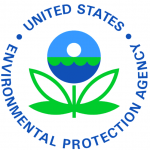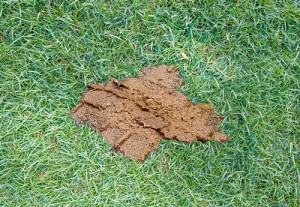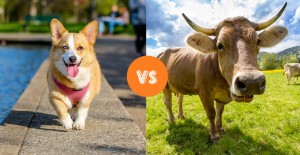
It is common belief that the use of your lawn mower can be a quick and convenient way to rid your yard of dog poop whilst adding rich fertilizer to your soil – this myth is about to get busted.
 Let’s start with this first fact – In 1991, the Environmental Protection Agency (EPA) had officially deemed pet waste as a “non-point source of pollution”, putting it in the same category as oil and toxic chemicals. Now picture walking through your backyard and you suddenly stop to find a small oil spill in your grass. What would you try to do in this situation? Would you take a rake and spread it out thinner in an attempt to dissipate it, or would you rather remove the oil spot completely at its source and have it taken off your property?
Let’s start with this first fact – In 1991, the Environmental Protection Agency (EPA) had officially deemed pet waste as a “non-point source of pollution”, putting it in the same category as oil and toxic chemicals. Now picture walking through your backyard and you suddenly stop to find a small oil spill in your grass. What would you try to do in this situation? Would you take a rake and spread it out thinner in an attempt to dissipate it, or would you rather remove the oil spot completely at its source and have it taken off your property?
It squishes and shreds, but does not vacuum
 Looks can be deceiving especially when you have the “out of sight, out of mind” attitude. The average lawn mower will cut your grass 1.5 – 3 inches tall – one might like to believe that the mower has finely chopped the unwanted excrement into oblivion, but more than likely it has simply flattened the droppings below the grass line and out of view.
Looks can be deceiving especially when you have the “out of sight, out of mind” attitude. The average lawn mower will cut your grass 1.5 – 3 inches tall – one might like to believe that the mower has finely chopped the unwanted excrement into oblivion, but more than likely it has simply flattened the droppings below the grass line and out of view.
Whether using a push mower or ride-on mower, those doggie poopies are smooshed, dispersed, and – as many unhappy landscapers will attest to – pressed into the inner workings of your wheels, leaving a quite unpleasant stench for future mows.
Let’s face it, not scooping before you mow can just make more problems in the long run – there’s much less of a chance to successfully scoop as the now flattened poops will be harder to find, meanwhile you and your family are more likely to inadvertently step onto the concealed waste and dragging it into the house.
I don’t understand the problem, isnt’ chopping it up just going to make good fertilizer for your lawn?
This is a common fallacy. The truth is that dog waste cannot serve as fertlizer on its own as it is very high in nitrogen and riddled with parasites that can actually contaminate your soil and spread harmful bacteria. It is only after dog waste is properly composted with other carbon materials for an extended period of time to form a humus that can then be recycled into the environment.
.
 Cattle are vegetarian by nature and produce the “ideal” manure for fertilizing that is mostly made of of digested grass and grain that has retained much of its nutrients . On average, their dung will contain about 3% nitrogen, 2% phosphorus, and 1% potassium, Upon comparison, dog poop has 2-1/2 times as much nitrogen and half as much potassium as cattle poo.
Cattle are vegetarian by nature and produce the “ideal” manure for fertilizing that is mostly made of of digested grass and grain that has retained much of its nutrients . On average, their dung will contain about 3% nitrogen, 2% phosphorus, and 1% potassium, Upon comparison, dog poop has 2-1/2 times as much nitrogen and half as much potassium as cattle poo.
 Too much nitrogen can lead to an imbalance in the soil, causing a significant decrease in calcium, phosphorus and magnesium. Ever wonder why you’re seeing yellow spots in your grass? You guessed it – an excess of nitrogen due to your dog’s bathroom habits.
Too much nitrogen can lead to an imbalance in the soil, causing a significant decrease in calcium, phosphorus and magnesium. Ever wonder why you’re seeing yellow spots in your grass? You guessed it – an excess of nitrogen due to your dog’s bathroom habits.
Going beyond the nitrogen issue, let’s further examine the potential dangers in your dog’s poop
At any given time, whether or not your dog is showing any signs of illness, just one gram of your dog’s waste can contain 23 million fecal coliform bacteria. Furthermore your dog may be carrying any number of pathogens located within their intestinal tract – including Giardia, Salmonella, and Roundworm. Your dog’s immune system may be successfully fighting off the contagion, but that does not mean their excrement is safe enough to leave situated in your backyard.
But I’ve had dogs all my life and they’ve never gotten me sick
 People often mistake symptoms that stem from a transmitted parasite to that of the flu virus. Most never suspect contracting a parasite as their immune system will most likely fight it off, however those with weakened immune systems such as children or senior adults can experience a more unfortunate outcome – gastrointestinal issues, pneumonia, and in rare cases even blindness. One does not need to touch it directly to become infected – any animal or human that sits or steps through that lawn will be at risk.
People often mistake symptoms that stem from a transmitted parasite to that of the flu virus. Most never suspect contracting a parasite as their immune system will most likely fight it off, however those with weakened immune systems such as children or senior adults can experience a more unfortunate outcome – gastrointestinal issues, pneumonia, and in rare cases even blindness. One does not need to touch it directly to become infected – any animal or human that sits or steps through that lawn will be at risk.
The lifespan of a poop is longer than you think
Even long after the dog waste has sat on the ground, dried out from the sun, it is still a danger to you and your family. It takes 2 weeks for the residing parasites to even hatch, and once hatched, those microscopic bugs – invisible to human eye – can survive for months or even years in your yard. Whipworms take the lead with the ability to last up to 7 years outside, exposed to the elements.
If you still wish to use your dog waste in your garden, you are going to want to use a few more tools than just your lawn mower. The composting process involves combining the manure with a carbon material (sawdust for example) and mix within an in-vessel container while reaching at least 150 degrees Fahrenheit during the initial part of the compost process. It can then take another 6-9 months for the compost to fully cure. If and when ready to use, it is highly suggested to use the end-product only on non-edible plants.
Consider hiring a pet waste removal company to ensure your yard is cleared before you mow. Pet Poo Skiddoo in Asheville, NC offers weekly and biweekly service plans so you can plan out what days to do your landscaping in a much safer, cleaner environment.

 How Enzymatic Cleaners Can Deodorize a Yard With Dogs
How Enzymatic Cleaners Can Deodorize a Yard With Dogs 5 Steps to Maintain a Healthy Lawn That Can Withstand Your Dog’s Urine
5 Steps to Maintain a Healthy Lawn That Can Withstand Your Dog’s Urine Is there a perfect type of mulch for a dog?
Is there a perfect type of mulch for a dog?